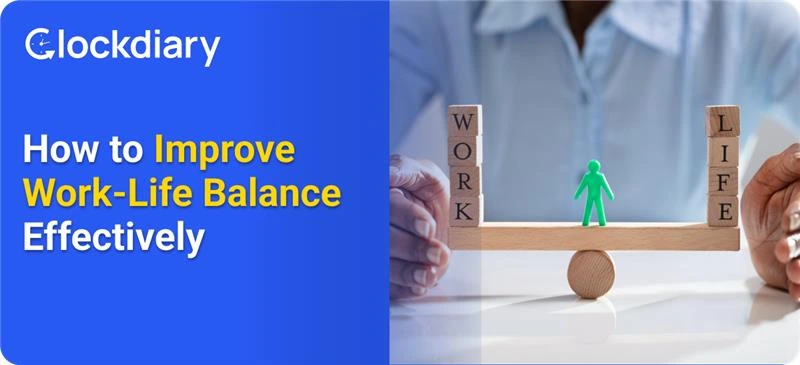

Are you struggling to find the right balance between your professional responsibilities and personal life? You’re not alone. Recent studies reveal that 66% of full-time employees in America feel they lack a healthy work-life balance, with 60% attributing this imbalance to their bosses. Thus, the need to improve work-life balance is perceived the most in this day and age.
Moreover, according to a survey conducted by FlexJobs in 2022, 87% of employees expect their employers to support them in balancing work and personal commitments. This begs the question: how to improve work-life balance for employees effectively?
| Quick Summary Struggling to maintain a healthy work-life balance? Whether you’re an employee, a manager, or working remotely, this guide offers practical strategies to help you set boundaries, avoid burnout, and reclaim your time. From effective time management to flexible work policies and mental wellness practices, discover how to improve your overall well-being and job satisfaction—both in the short and long-term. In this blog, you’ll discover: ⦿ What work-life balance really means and why it’s vital for mental and physical health ⦿ 10 clear signs of poor balance and how to recognize them early ⦿ Actionable tips employees can use to prioritize personal and professional goals ⦿ What managers can do to foster a healthier work culture ⦿ Work-from-home best practices for boundary-setting and wellness ⦿ Long-term habits to maintain balance and avoid burnout ⦿ Why Clockdiary is the ideal tool to support work-life balance through smart time tracking |
Such an imbalance not only affects individual well-being but also impacts organizational productivity. In this blog, we’ll explore practical strategies for both employees and managers to ensure a harmonious work-life balance, enhancing satisfaction and efficiency in the workplace.
Work-life balance means effectively managing work responsibilities while ensuring personal well-being. It’s about creating a sustainable routine where career growth and personal life coexist without overwhelming one another.
Many believe work-life balance means splitting time equally between work and personal life, but that’s a myth. In reality, it’s about flexibility and integration—finding a rhythm that works for you. On some days, work may take priority; on others, personal time comes first. The key is maintaining a balance in life that prevents burnout while keeping you productive and fulfilled in both areas. Timeboxing can come in handy here. A healthy balance reduces stress, prevents burnout, and boosts productivity. It’s about smart choices, not strict schedules.
Maintaining a healthy work-life balance is crucial for overall well-being. Recognizing the signs of poor work-life balance can help you take corrective measures. Here are key indicators:
One of the clearest signs of an unhealthy work-life balance is burnout. When work becomes overwhelming and relentless, it can lead to emotional, mental, and physical exhaustion. Burnout often results in a loss of motivation, increased stress levels, and a feeling of detachment from work.
As former First Lady Michelle Obama emphasized, “We need to do a better job of putting ourselves higher on our own ‘to-do’ list.” Prioritizing self-care is essential to prevent burnout and improve work-life balance effectively.
Constant exhaustion, even after a full night’s sleep, is a red flag. When work takes over your life, your body doesn’t get enough time to recover. This prolonged fatigue can impact concentration, decision-making, and overall well-being, making even simple tasks feel overwhelming.
If staying late at work or bringing tasks home has become the norm, it’s a sign your work is taking up too much of your personal time. Research shows that 38% of workers feel they work too much, and 46% report never having time to relax, indicating a pervasive culture of overwork.
Regular overtime can lead to increased stress, strained relationships, and a reduced quality of life.
A poor work-life balance often means neglecting essential self-care activities like exercise, hobbies, and relaxation. When work consumes all your time, your physical and mental well-being suffer, leading to long-term health issues.
Overworking can contribute to feelings of isolation, anxiety, and even depression. If you frequently feel overwhelmed, unmotivated, or emotionally drained, your work-life balance may be negatively impacting your mental health.
Ironically, working too much can make you less productive. Lack of rest and constant stress reduce efficiency, creativity, and problem-solving skills. You may find yourself making more mistakes and struggling to meet deadlines.
If you’re constantly feeling frustrated, impatient, or short-tempered with colleagues, family, or friends, it could be due to an unhealthy balance between work and personal life. Emotional exhaustion often manifests as irritability and difficulty managing stress.
The Mental Health Foundation notes that it can be easy to normalize working long hours or being under extreme stress, especially if we’ve been doing it for a long time.
Here is a bar graph illustrating the prevalence of symptoms associated with poor work-life balance:
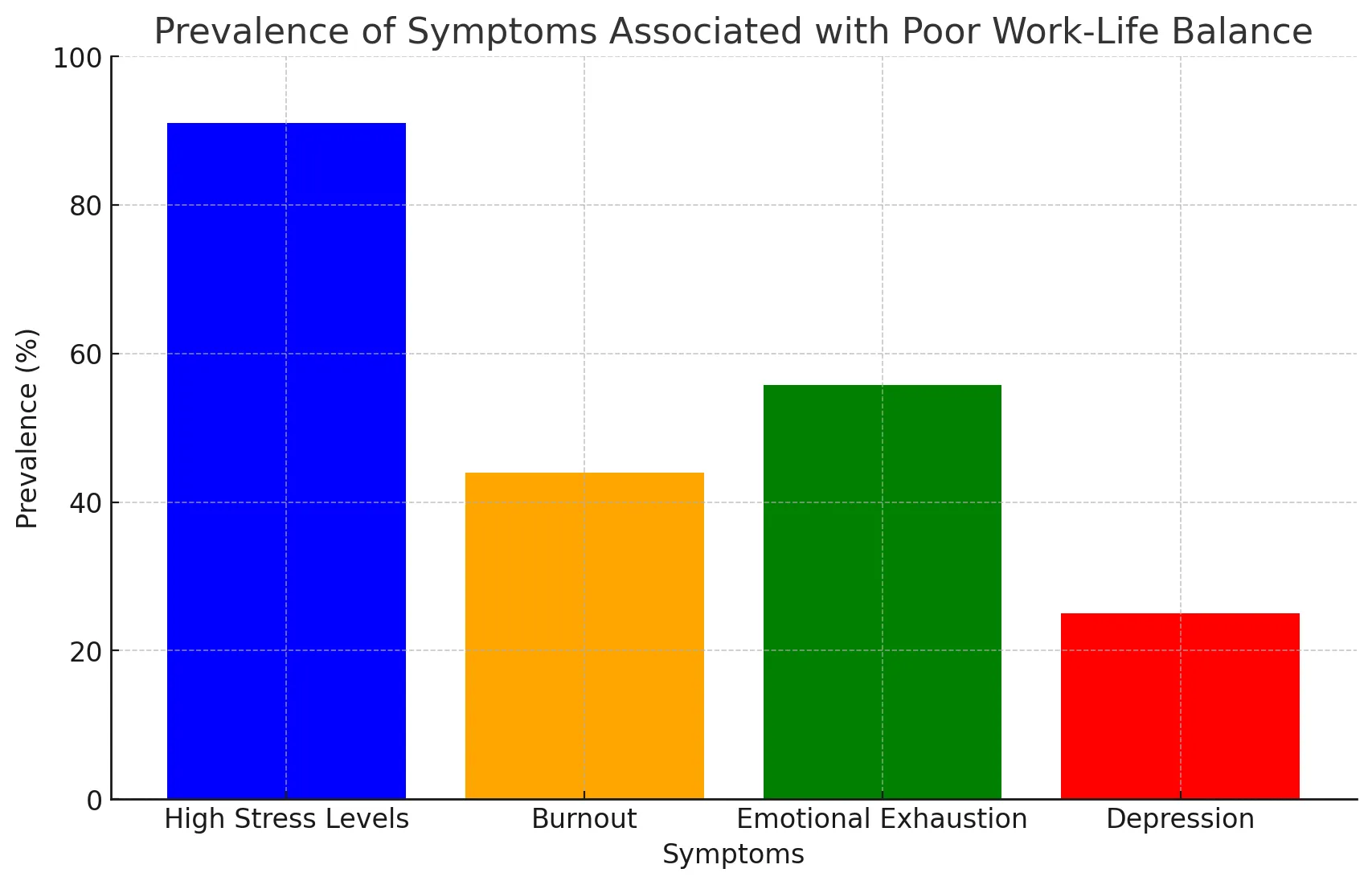
Recognizing these signs is the first step toward improving work-life harmony. Implementing strategies such as setting boundaries, prioritizing tasks, and dedicating time to personal well-being can lead to improved health and job satisfaction.
Achieving a harmonious work-life balance is absolutely essential for personal well-being and professional productivity. Here are ten effective strategies to help employees improve work-life balance effectively:
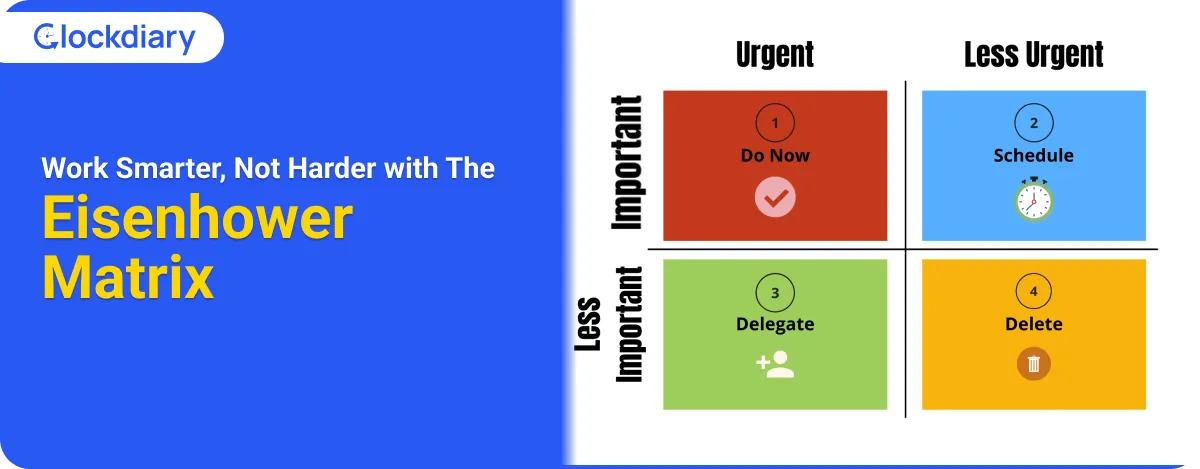
One of the most effective ways to improve work-life balance is by planning your tasks strategically. The Eisenhower Matrix helps categorize tasks based on urgency and importance:
Research indicates that 100% of individuals employing the Eisenhower Matrix feel their work is under control four to five days per week. This method helps employees focus on what truly matters, reducing stress and preventing last-minute work overload.

Time management is key to maintaining balance in life. Time management apps come in handy here. Clockdiary, a free time-tracking tool, allows employees to monitor how they spend their work hours.
By tracking tasks, employees can identify inefficiencies and make adjustments to improve productivity, ensuring they don’t spend unnecessary extra hours at work.
Many employees struggle with separating work from personal time, especially with remote work. This arises the definite question, how to improve work-life balance while working from home.
Setting clear work hours and sticking to them can prevent work from spilling into personal life. Avoid checking emails or taking calls after hours to maintain a clear distinction between work and home life.
The Pomodoro Technique, developed by Francesco Cirillo, helps boost productivity while preventing burnout. It involves:
This method enhances concentration while ensuring employees don’t exhaust themselves by working non-stop. Pomodoro timer apps help achieve just that.

Many employees hesitate to discuss workload concerns, fearing they might seem inefficient. However, open communication with managers can lead to better task distribution and realistic deadlines. If you’re feeling overwhelmed, speak up and suggest solutions that benefit both you and the company.
If your employer offers remote work, hybrid schedules, or flexible hours, take advantage of them. These work arrangements go a long way to improve work-life balance effectively.
A study by the American Psychological Association found that flexible work policies are associated with higher job satisfaction and reduced stress. Employees can better integrate personal and professional responsibilities with such schedules.
Many employees leave vacation days unused, fearing workload accumulation. However, taking time off is essential for mental well-being. Plan vacations in advance and use them fully to recharge. Many companies offer unlimited PTO policy as well. A well-rested employee is more productive and motivated.
Work should not take precedence over personal health. Prioritizing activities like exercise, meditation, and hobbies improves mental and physical well-being. As author and motivational speaker Zig Ziglar stated, “You don’t have to be great to start, but you have to start to be great.” Making time for these activities helps employees feel more fulfilled both at work and in life.
Overcommitting leads to stress and exhaustion. Learning to say NO when your plate is already full is crucial. As Warren Buffett advises, “The difference between successful people and really successful people is that really successful people say no to almost everything.”
Be polite yet firm—offering realistic deadlines or alternative solutions can help maintain professionalism while ensuring work-life harmony.

A strong support system at work and home improves overall happiness. Engage with colleagues, build relationships, and make time for family and friends. Meaningful connections reduce stress and provide emotional support, making work-life balance easier to achieve.
By implementing these strategies, employees can improve their work-life balance, enhancing both productivity and overall well-being.
A healthy work-life balance isn’t just the employee’s responsibility—it requires support from managers and leaders. They often wonder: how to improve work-life balance in an organization. When organizations prioritize work-life balance, employees are happier, more engaged, and more productive. Here’s how managers can help improve work-life balance effectively:
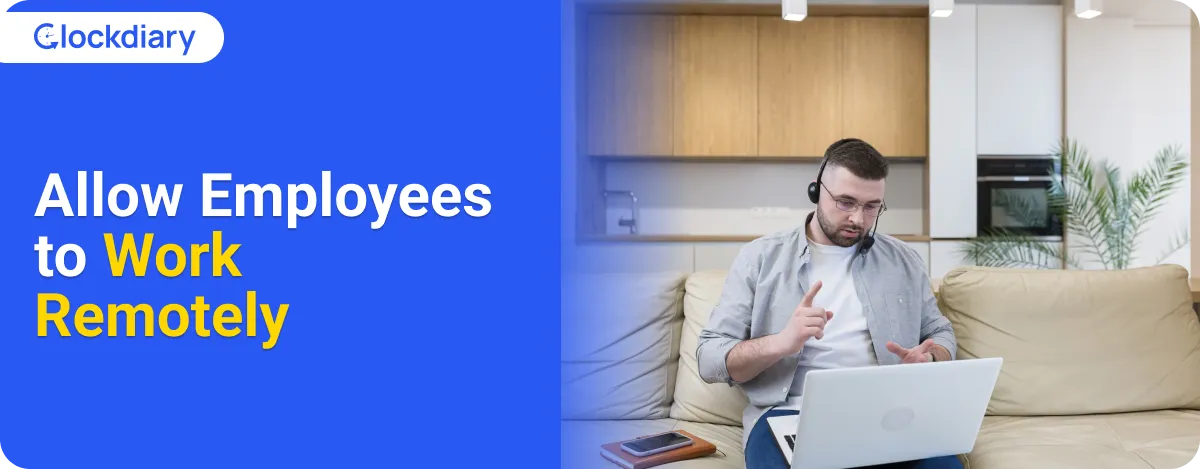
One of the most effective ways to improve work-life balance for employees is by offering flexible work arrangements. There are different work schedule types, like first shift, second shift, third shift, swing shift, and rotating shifts. Studies indicate that 79% of U.S. workers believe flexible working options would allow for a better work-life balance.
Allowing employees to work remotely, choose flexible hours, or adopt a hybrid schedule gives them the freedom to manage personal responsibilities while maintaining productivity as well. Furthermore, there are quite a number of effective strategies for managing virtual teams that you can employ to ensure productivity remains unaffected.
When employees have control over their schedules, they experience less stress and perform better.
Many employees hesitate to take time off, fearing workload accumulation or employer disapproval. Managers should actively encourage employees to use their paid leave and even implement mandatory time-off policies to prevent burnout.
Offering mental health days and ensuring smooth workload distribution when employees are on leave promotes a healthier work environment.
Non-stop work leads to exhaustion and reduced efficiency. Managers should promote the Pomodoro Technique or similar time management strategies that encourage short breaks between tasks.
Encouraging lunch breaks away from desks and promoting walk-and-talk meetings can improve both productivity and well-being.
Employees shouldn’t feel pressured to be available 24/7. Managers must set clear expectations about communication outside of working hours. As entrepreneur Damon Dash noted, “Part of keeping work and life in balance is surrounding yourself with people that have similar aspirations.”
Establishing “no-email after-hours” policies and discouraging weekend work helps employees disconnect and recharge.
Best time-tracking apps like Clockdiary help managers track employees’ work patterns without micromanaging. These insights help ensure no one is overworking and allow managers to make adjustments to optimize productivity while maintaining balance.
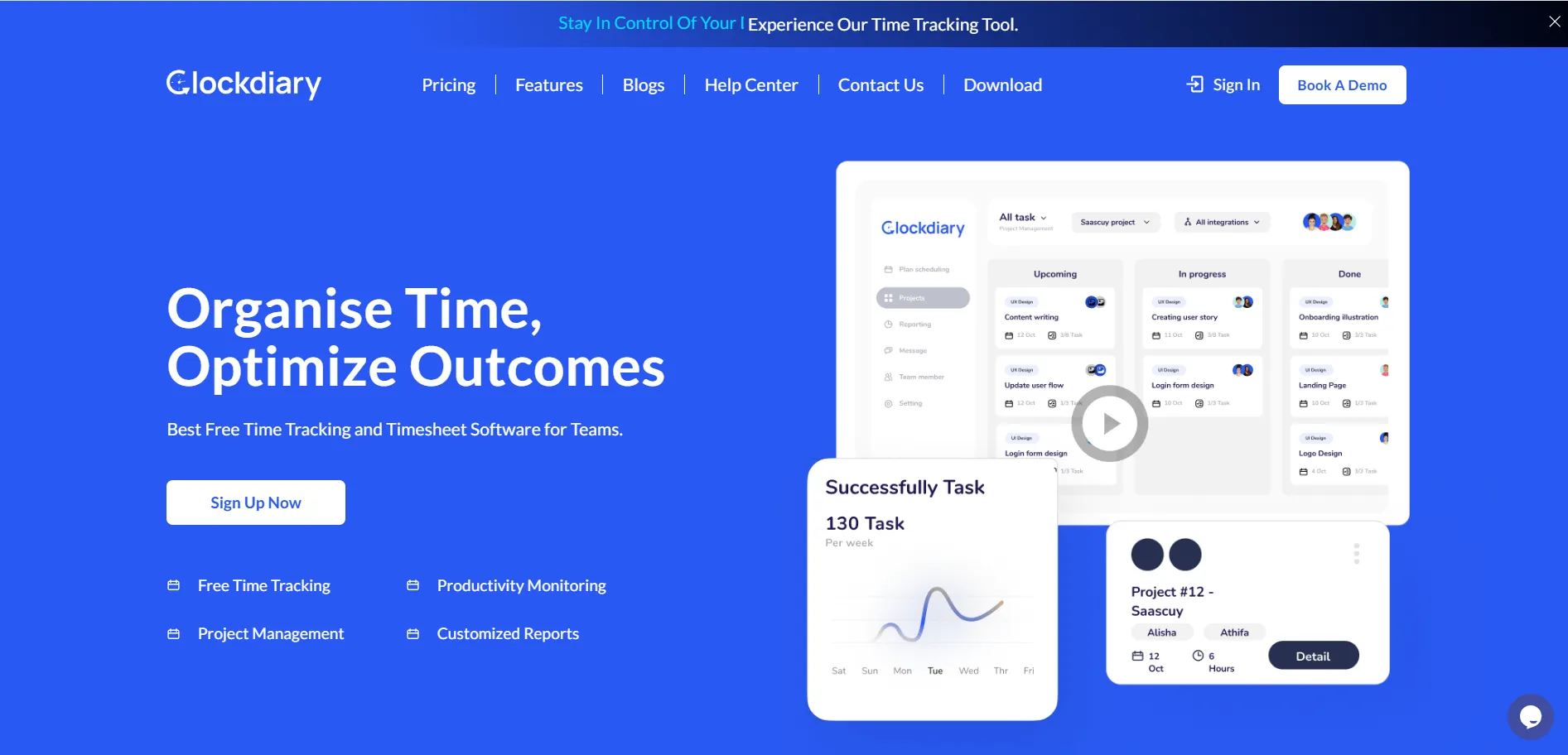
By encouraging time tracking, managers can help employees manage workloads efficiently and avoid excessive overtime.
If managers regularly work late, send emails after hours, or skip vacations, employees may feel pressured to do the same. Leaders must model the behavior they expect—leaving work on time, taking breaks, and using their vacation days.
When managers practice work-life balance, it encourages employees to do the same without guilt.
Promoting employee wellness programs—such as gym memberships, mental health support, or wellness workshops—can significantly improve work-life balance for employees. Research by the World Health Organization (WHO) shows that companies investing in employee wellness see reduced absenteeism and higher engagement.
Encouraging movement, meditation, or even offering counseling services shows that the company values employees’ well-being.
Overloaded employees struggle to maintain balance in life. Managers should regularly check in with their teams to ensure workloads are reasonable and evenly distributed.
Delegating tasks effectively, prioritizing projects, and eliminating unnecessary meetings can help prevent burnout.
Instead of focusing on long work hours, managers should measure success based on output and efficiency. Recognizing employees for completing quality work rather than simply putting in more hours creates a culture of smart working instead of overworking.
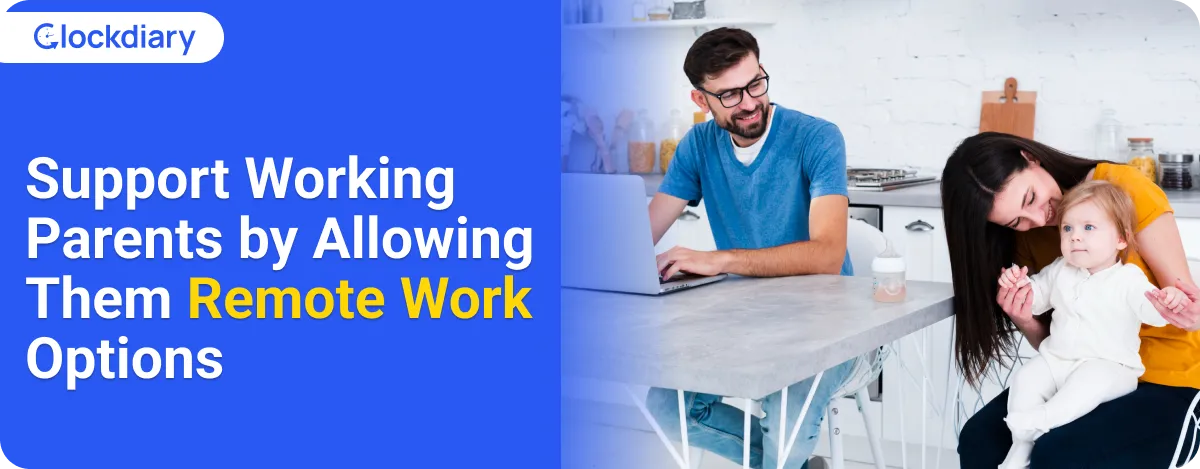
Working parents face unique challenges balancing professional and family responsibilities. Facebook’s Sheryl Sandberg advocates for workplace policies that support parents, recognizing their contribution to the workforce.
Providing options like childcare assistance, flexible schedules, or remote work options can make a huge difference. Family-friendly policies lead to happier, more engaged employees who stay loyal to the organization.
By implementing these strategies, managers can create a healthier, more productive work environment where employees feel supported in maintaining their work-life balance.
Remote work offers flexibility, but it also blurs the lines between professional and personal life. Without proper boundaries, work can seep into personal time, leading to burnout and reduced productivity. Here comes the question: how to maintain work-life balance while working remotely?
Here are the best strategies to maintain a healthy work-life balance while working remotely:
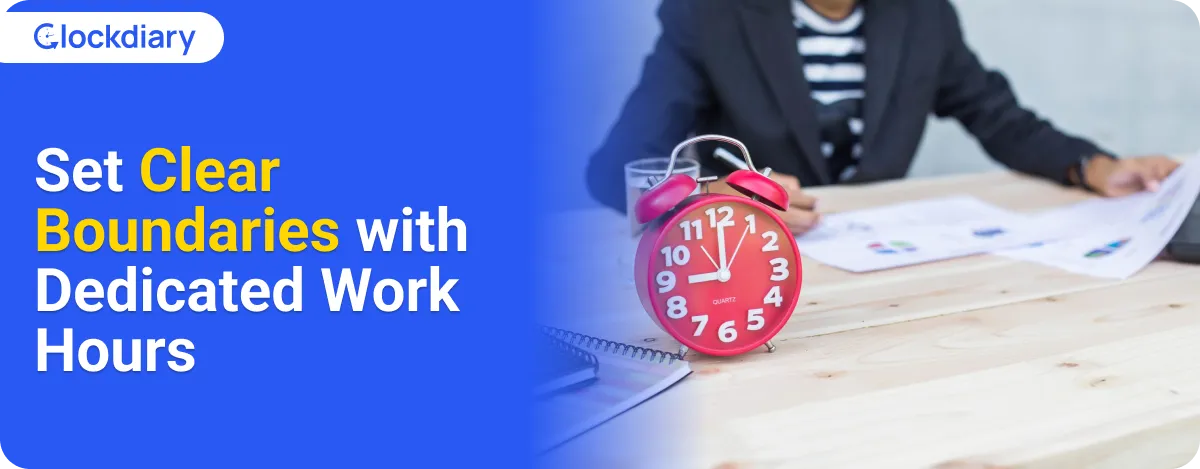
One of the biggest challenges of remote work is the lack of structure. According to a survey, 60% of U.S. workers reported lacking boundaries between work and personal life, leading to increased stress.
Establishing clear start and end times for your workday helps create separation between professional and personal life. Stick to a schedule just as you would in an office setting, and communicate these boundaries with your team to prevent unnecessary interruptions.
Working continuously without breaks reduces productivity and increases fatigue. Use techniques like the Pomodoro Technique—work for 25 minutes, then take a 5-minute break. Step away from your desk, stretch, or go for a short walk to refresh your mind. This is a great way to improve work-life balance while working remotely.
Working from bed or the couch can make it difficult to switch between “work mode” and “home mode.” Setting up a dedicated workspace improves focus and helps signal to your brain when it’s time to work and when it’s time to relax. Ideally, choose a quiet area with minimal distractions.
Staying organized is key to maintaining work-life balance. Tools like Clockdiary help track work hours, ensuring you don’t overwork.
Focus timers also help maintain balance by structuring work sessions and break periods, increasing efficiency while preventing burnout.
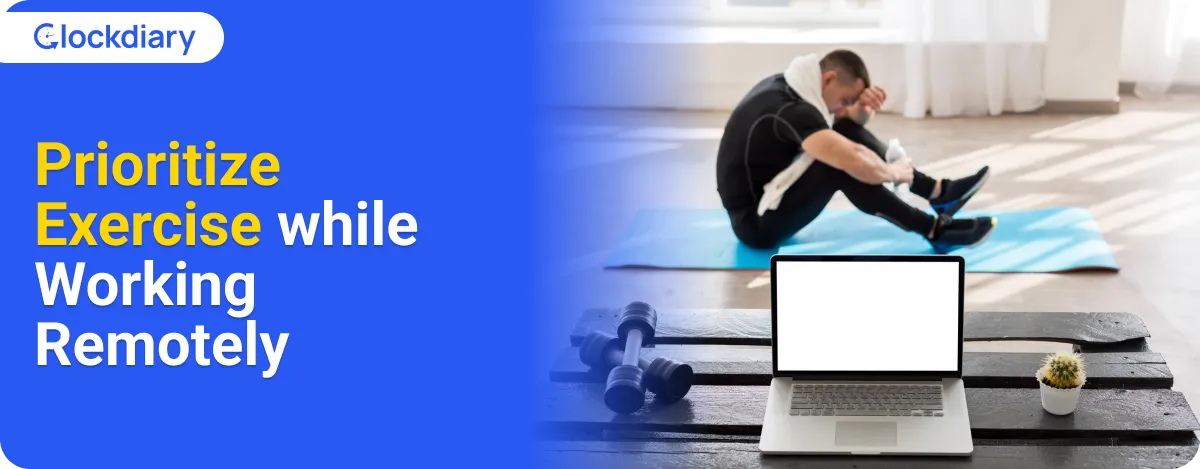
Sitting for long hours can negatively impact both physical and mental health. Incorporate movement into your day—take a morning walk, do a quick workout, or stretch between meetings.
A study found that employees who engage in regular physical activity report higher levels of work-life balance. Physical activity boosts energy levels and improves overall well-being.
Remote work can sometimes feel isolating. Regular communication with colleagues helps maintain collaboration and team spirit. Use chat apps, video calls, and emails to stay connected, and don’t hesitate to ask for help or clarification on tasks.
As entrepreneur Jim Rohn stated, “Either you run the day, or the day runs you.” Prioritizing tasks and setting realistic deadlines are key components of effective time management.
Utilizing tools like to-do lists or digital planners can help organize tasks and allocate appropriate time for each. Efficient time management reduces stress and enhances productivity.
One of the biggest challenges of remote work is the temptation to stay online after hours. A survey indicated that 67% of employees experienced improved work-life balance after starting remote work, highlighting the importance of disconnecting.
Once your work hours are over, log off from work emails, mute notifications, and step away from your workspace. Creating a clear “end-of-day” ritual, like taking a walk or reading, helps signal the transition from work to personal time, thereby ensuring balance in life.
Even if you work remotely, taking vacations and mental health days is essential. Step away from work to fully relax and recharge. Avoid checking work emails or messages during time off to truly disconnect.

Work should not consume your entire day. Set aside time for hobbies, social activities, or simply unwinding. Whether it’s reading, painting, or spending time with family, personal activities help recharge your mind and improve overall happiness.
By following these strategies, remote workers can maintain a healthy balance between professional and personal life, leading to improved well-being and higher productivity.
Achieving a sustainable work-life harmony is essential for long-term success and well-being. Implementing effective strategies can help individuals manage their professional responsibilities while nurturing personal fulfillment. Here are some innovative ideas for work-life balance to consider:

Effective time management is the cornerstone of a balanced life. As leadership expert Stephen Covey stated, “The key is not to prioritize what’s on your schedule, but to schedule your priorities.”
Prioritize tasks by creating daily or weekly plans, focusing on high-impact activities. Utilize tools like to-do lists or digital planners to organize tasks and set realistic deadlines. Regularly assess and adjust your plans to accommodate changing priorities.
Taking time off is crucial for rejuvenation. Beyond traditional vacations, consider shorter, more frequent breaks or mental health days to prevent burnout.
Some companies offer flexible time-off policies, allowing employees to take leave as needed, fostering a culture that values well-being.
Setting specific times for professional communication helps maintain boundaries. Clearly communicate your availability to colleagues and clients, and adhere to these periods for work-related interactions.
This practice ensures uninterrupted personal time and reduces stress associated with constant connectivity.
Detaching from work during off-hours is vital. Avoid checking emails or engaging in work tasks once you’ve concluded your workday. We would like to point out here that according to a research conducted by McKinsey and Company in 2022, approximately 50% of employees have difficulties disconnecting from work when at home.
Creating a physical separation, such as a designated workspace, can reinforce this boundary, signaling to your mind when it’s time to work and when it’s time to relax.

Identify tasks that align with your strengths and delegate others when possible. Delegation not only lightens your workload but also empowers team members by entrusting them with responsibilities.
This collaborative approach enhances efficiency and promotes a supportive work environment, something that goes a long way to improve work-life balance for long-term success.
Allocating days specifically for mental health can significantly impact overall well-being. Use these days to engage in activities that relax and rejuvenate you, such as hobbies, exercise, or spending time in nature. Recognizing the importance of mental health contributes to sustained productivity and personal satisfaction.
Incorporate regular exercise, balanced nutrition, and adequate sleep into your routine. Physical health directly influences mental clarity and energy levels. Employees who engage in regular physical activity report higher levels of work-life balance.
Simple practices like taking short walks, mindful eating, and maintaining a consistent sleep schedule can profoundly affect your daily performance and mood.
Joining employee resource groups (ERGs) can offer a sense of community and shared experiences. ERGs provide support networks and advocate for work-life balance initiatives within the organization, thereby promoting an inclusive environment.
Maximizing productivity during work hours reduces the need for overtime and preserves personal time. Implementing strategies such as questioning the purpose of meetings and limiting their length can help maintain focus and productivity.

Participating in wellness programs offered by employers can provide additional support. These programs may include fitness classes, stress management workshops, or counseling services. Engaging in such initiatives promotes a culture of health and balance.
By implementing these strategies, individuals can improve work-life balance to a great extent, thereby cultivating a harmonious balance between professional obligations and personal life, leading to sustained success and well-being.
Achieving a healthy work-life balance is essential for both employees and managers, as it impacts various aspects of personal well-being and organizational success. Here’s why it matters:
A lack of work-life balance often leads to chronic stress, anxiety, and even physical health issues like high blood pressure and fatigue. Against this backdrop, we would like to point out that according to a Deloitte survey, a concerning 77% of global workers have experienced burnout in their current jobs, indicating a prevalent imbalance.
Employees who can set boundaries between work and personal life experience lower stress levels, improved mental well-being, and better overall health. Taking breaks, exercising, and getting enough rest contribute to long-term wellness.
Contrary to popular belief, working longer hours doesn’t always mean getting more done. Not just that, they often resort to procrastination, making overcoming procrastination that much more important. Employees with good work-life harmony are more focused and efficient during work hours.
Studies show that well-rested employees perform better, make fewer mistakes, and contribute more effectively to team goals. Notably, 85% of businesses implementing work-life balance initiatives report increased productivity.
Spending quality time with family and friends is crucial for emotional well-being. Poor work-life balance can strain personal relationships, leading to dissatisfaction both at home and in the workplace.
As author Heather Schuck aptly stated, “You will never feel truly satisfied by work until you are satisfied by life.” By prioritizing personal time, employees strengthen connections and feel more supported in all aspects of life.
Employees who feel they have control over their work and personal time are generally happier with their jobs. Organizations that help improve work-life balance through flexible schedules, remote work options, and wellness programs see higher retention rates and improved workplace morale.
Burnout is a serious issue that affects both employees and employers. This might come to you as a surprise but 71% of Generation Z employees and 59% of Millenials reported unhealthy work health scores.
Long hours without adequate breaks can lead to emotional exhaustion, decreased motivation, and high turnover rates. A balanced approach to work helps individuals stay energized and engaged.
With remote and hybrid work models becoming more common, work-life integration is more relevant than ever. Employees who can manage their work and personal responsibilities seamlessly experience less stress and higher overall satisfaction.
Organizations prioritizing work-life balance tend to experience higher employee retention rates. Research indicates that 43% of Australian workers are prepared to leave their jobs as soon as the economy improves, often due to feeling undervalued and seeking better work-life balance.
By fostering a supportive environment, companies can retain talent and reduce turnover costs.
Here is a pie chart illustrating the benefits of maintaining a healthy work-life balance :
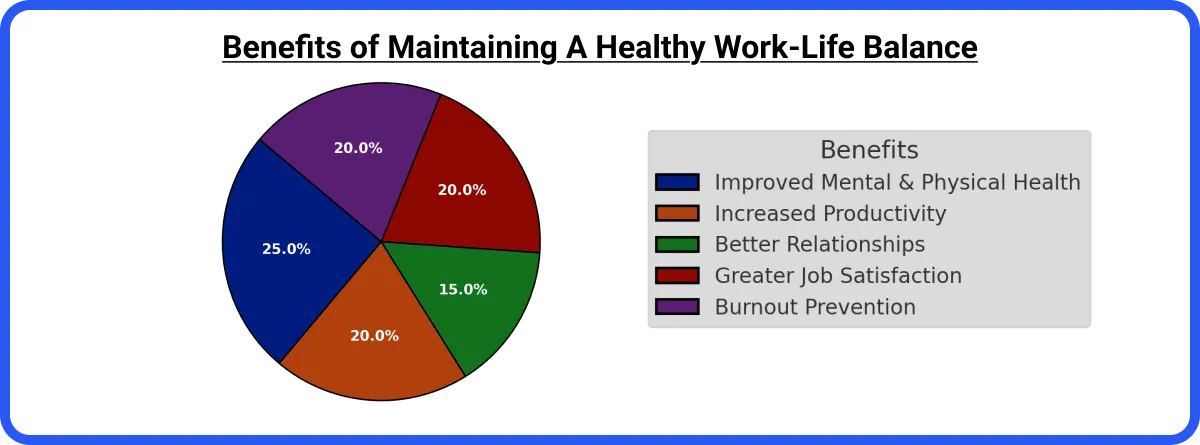
In summary, improving work-life balance is not merely a perk but a necessity for sustaining a healthy, productive, and committed workforce.
Achieving work-life harmony is essential for both personal well-being and professional productivity. To that end, tracking your daily activities is extremely important. Clockdiary, a versatile time-tracking tool, offers several features designed to help individuals and teams manage their time effectively, ensuring that work commitments do not encroach upon personal life. Some of its key features include:
By leveraging these features, Clockdiary empowers users to maintain a balanced approach to work and personal life, fostering long-term success and well-being. Get in touch with us to make this technological wizardry a part of your daily life and see the difference for yourself.
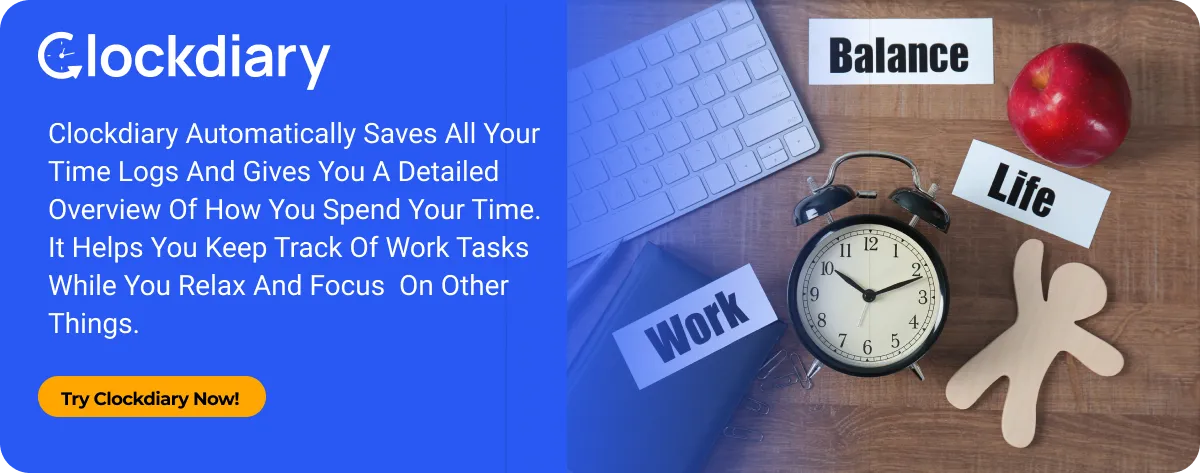
Frequently Asked Questions:
Achieving a healthy work-life balance involves five key steps:
Prioritize tasks to focus on what truly matters, ensuring alignment with personal and professional goals.
Manage your time effectively by scheduling activities and setting realistic deadlines to prevent over-commitment.
Set boundaries to delineate work from personal life, protecting time for relaxation and family.
Take regular breaks to rejuvenate and maintain productivity.
Finally, take care of yourself by engaging in activities that promote physical and mental well-being, such as exercise, hobbies, and sufficient rest.
The most common cause of poor work-life balance is an excessive workload, where individuals are overwhelmed by numerous tasks and projects, leading to long working hours and diminished personal time.
Struggling with work-life balance often stems from factors such as workplace stress, financial worries, and job insecurity, leading individuals to overextend themselves professionally at the expense of personal well-being.
Additionally, the pervasive use of digital devices blurs the boundaries between work and personal time, making it challenging to disconnect and relax.
A consistent 40-hour workweek is widely regarded as the best work schedule for work-life balance, with flexible options like adjusting clock-in clock-out times or providing work from home opportunities. Such a schedule provides sufficient time for both professional responsibilities and personal activities. This structure allows individuals to fulfill work commitments while preserving ample opportunity for rest, family engagement, and leisure pursuits.
Achieving a healthy work-life balance involves setting clear boundaries between professional and personal time, effectively managing your schedule to prioritize essential tasks, and ensuring regular self-care activities to maintain overall well-being. By implementing these practices, you can foster a harmonious integration of work and life, leading to sustained productivity and personal satisfaction.